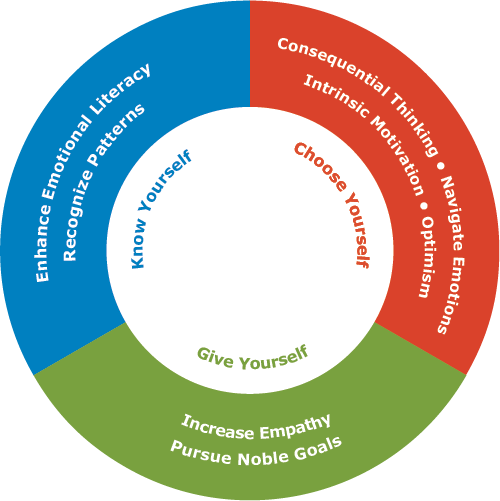How to Vitalize Hiring with Emotional Intelligence
It’s tough to get the right people with the right skills in the right seats. It’s equally difficult to onboard those new hires in a way that inspires them and sets the stage for sustainable success. Hiring isn’t easy, but emotional intelligence can help. It’s an indispensable lens through which to frame and conduct the hiring process, from start to finish. How, exactly, do you integrate EQ into hiring?
After extensive research, Six Seconds has identified the following best practices to use emotional intelligence effectively in all aspects of the hiring process.
Recommendations follow for Employer Branding, Selection, and Onboarding.
The trend in the past was behavioral interviewing. The premise was to train interviewers to detect signals of emotional intelligence (EQ). It was a good idea, but hard to do well. The next evolution was using full-blown EQ assessments. This approach offered excellent data, but was awkward to use in an interview and much too expensive for large-scale hiring. Here are our recommendations for an integrated approach of best practices for hiring with emotional intelligence.
First, a preview:

Employer Branding
use emotional intelligence data and vocabulary to attract quality talent.

Hiring / Selection
apply “just simple enough” emotional intelligence metrics to get the right people.

Employee Onboarding
integrate skills and vocabulary to onboard talent in a way that improves retention.
Employer Branding: Attracting Emotionally Intelligent Applicants
Are you a great employer, where talented, innovative, committed employees will thrive? Employer branding is about letting prospective employees know you’re the kind of organization to which “high EQ people” should apply. Try the following:
-
Add emotional intelligence to job descriptions & promotion (see Adobe’s example).
-
Use a relational process (like Zappos Insider).
-
Commission custom research to quantify your company’s commitment to EQ; do this on an ongoing basis to show trends. [1]
Adobe makes it clear why they value EQ in potential candidates
Selection: Hiring for Emotional Intelligence
Use a well-validated emotional intelligence assessment. Some tests are too simplistic (you can get whatever score you want), while others are overly complex (it takes an hour just to begin to understand the report). The right tool has strong psychometrics and a simple output. Here is an analysis of several well-validated emotional intelligence tests. [2]
The way to use emotional intelligence in selection depends on your situation:
- Filter a large number of candidates: screening
- Distinguish between final candidates: interviewing
- Go in-depth with senior candidates: critical selection
Case 1: Screening a Large Group
Challenge: Selecting the best candidates from a large pool of applicants
The first step is a needs assessment. What EQ capabilities are important in this specific role? You can assess this through an informal process of discussion or do formal research to see the specific capabilities of high-performing individuals in this role; this creates a target. [3]
Candidates take the EQ assessment and you generate a spreadsheet of results. Then you have specific EQ data to add to your selection process of who to interview. [4]
Case 2: Interviewing or Small Selection
Challenge: Use emotional intelligence to distinguish qualified candidates
In this case, you want a simple emotional intelligence profile that you can discuss in an interview. It should provide data that allows you to conduct a more effective interview by grounding the conversation in data. At the same time, a full-depth assessment is not ideal because it takes too much time and is too complex. [4a]
Case 3: Senior Candidates and Critical Selection
Challenge: Go in-depth on emotional intelligence to understand capabilities and fit
More senior positions warrant a deeper dive into emotional intelligence, measuring a range of competencies. This requires certification training so a recruiter can effectively interpret the EQ data and discuss the results in a meaningful way with the candidate. [5]
In this situation, it’s also important to understand the fit between the prospective leader and team. Having a group profile of the team’s EQ SWOT creates a powerful conversation where the recruiter can let the candidate understand the dynamics and needs of the situation. The group summary has to be structured in a way that has depth and meaning, but doesn’t reveal any controversial or confidential data. [6]
Onboarding: Embedding Emotional Intelligence
To gain full value from emotional intelligence in the hiring process, these concepts need to become integrated into the culture of the organization. New hire training is an excellent forum to introduce this vocabulary. Ideally, senior leaders are walking the talk when it comes to emotional intelligence. If they’ve gone through EQ assessment and coaching, it’s very powerful if they’re the ones presenting EQ content in the new hire training.
Next, the team manager can bring a new person into the team quickly by using EQ. Focus on identifying and sharing each team member’s EQ-related strengths and how those link to the roles and goals of the team. This fosters practical conversation about the team culture and the new person’s fit. Using a strengths-based approach is key to creating buy-in and boosting energy for the new hire and the team. [7]
With emotional intelligence embedded from the beginning, the stage is set for ongoing consideration of EQ competencies in performance appraisal and professional development. Early indicators suggest this kind of onboarding process will improve employee retention (see the Zenet example)
The Bottom Line: Vitalizing the Hiring Process with EQ
More organizations are seeing that “how we do our work” is essential to performance, so they’re looking for employees who have the skills to connect, collaborate, and commit. Emotional intelligence is invaluable.
Best practices for using emotional intelligence in hiring include:
-
Design a complete process from recruitment to onboarding.
-
Use a robust assessment to have reliable data.
-
Distill the data into a simple form that’s practical and meaningful at each stage.
Just fill in this form and we’ll send you the sample EQ resources that organizations have used to vitalize hiring with emotional intelligence:
Notes
Here are several tools and resources that Six Seconds publishes that are well suited to the different stages of selection:
[1] An example of this is the Six Seconds global State of the Heart Report. This type of data can be created within an organization. You can request a copy using the form to the right.
[2] The Six Seconds Emotional Intelligence assessment, SEI, works well in hiring. SEI is practical and it’s extremely well validated (over 100,000 people in the dataset, robust psychometrics, numerous national norms). There are multiple outputs to meet selection needs and more information can be found here: http://6seconds.org/tools/sei/sei-eq-assessment/.
[3] The Six Seconds DNA Profile is a quick way to correlate in-house performance measures with EQ scores for a specific organization or role. Request a copy using the form to the right.
[4] A Selection Matrix spreadsheet is available from the SEI for groups to quickly view and sort by various key capabilities. Request a copy using the form to the right.
[4a] The Brain Discovery Profile is an example of a highly effective 1-page summary of key emotional intelligence assets and challenges. It can be shared with a candidate for an open discussion, and has built-in questions for a structured interview process. A sample is included with the files you can download using the form above-right..
[5] The SEI Leadership Report is ideal for this process because it has great depth, but is also easy to understand.A sample is included with the files you can download using the form above-right..
[6] Tools include the SEI Group Report or the Brain Profile Team Dashboard. A sample Dashboard is included with the files you can download using the form above-right.
[7] More on the Brain Talent and other Profiles is here: http://6seconds.org/tools/sei/profiles/
authors: Joshua Freedman, Paul Stillman, Lorenzo Fariselli, Jan 29, 2016
What’s new in emotional intelligence?
How Emotional Intelligence Drives Personal, Social, and Environmental Sustainability
Discover how emotional intelligence is the missing link to achieving sustainability—personally, socially, and environmentally—in a world facing emotional recession and AI-driven burnout.
The Motivation Iceberg: 3 Tips to Unleash Motivation
How do you use emotional intelligence to fuel lasting motivation? The Motivation Iceberg is a simple, clear model for understanding how to motivate – even in WFH during a pandemic.
How to Thrive in a BANI World: Insights from the World’s Largest Study of Emotional Intelligence
Emotional intelligence is declining just when we need it most. Drawing from the the world’s largest EQ study, this article explores why and how to reverse the trend—with women leading the way toward emotionally intelligent leadership.
Why True Leaders Must Think Like Trainers: How to Use Emotional Intelligence to Excel in a Leadership Role
Discover how Emotional Intelligence and a trainer’s mindset can transform leadership, fostering growth, autonomy, and long-term success.
The Six Seconds Model of Emotional Intelligence: What It Is and How to Use It (+ PDF)
What is emotional intelligence and how do you practice it? Explore the Six Seconds Model of Emotional Intelligence to improve your life and relationships.
Unlocking Performance 2.0: Why Emotional Intelligence Is the Key to Leading in a BANI World
Are we looking for solutions in the right place? What if the key to success isn’t stricter control and efficiency, but more empathy and trust?
- Emotions As a Motivation Supercharger: 3 Essential Questions to Feel Motivated - July 7, 2025
- The Motivation Iceberg: 3 Tips to Unleash Motivation - June 28, 2025
- How to Control Emotions Without Shutting Them Down: A 3-Step Process That Actually Works, and the Neuroscience Behind the Technique - June 15, 2025







Great article Josh happy to share how we are utilising EQ in the solutions if anyone wants more info
Great article Joshua! I’m curious if you have any examples of how emotional intelligence data has been used in employer branding. Seems like a very interesting idea.